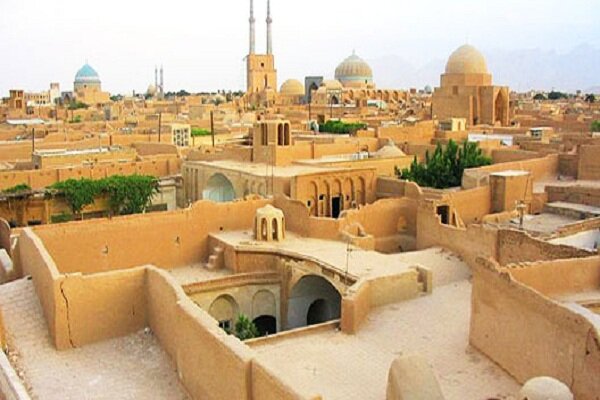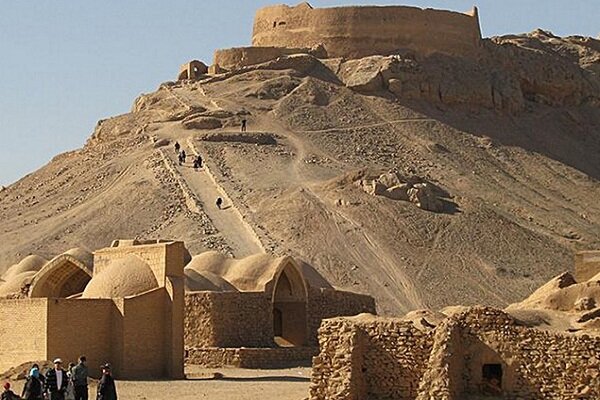Location
Yazd is located right at the center of Iran. It is located almost 270 km southeast of Isfahan and is 631 km away from the Iranian capital, Tehran.
History
The name of Yazd is derived from Yazdegerd I, a Sassanid ruler of Persia. Originally, Yazd was called Isatis at the time of the Median Empire when it emerged. The city prospered under Sassanians when it was a center of the followers of the Zoroastrian faith. Because of its remoteness from central Iran and populated areas, it has escaped devastating assaults of the foreign invaders like Chengiz Khan. Instead, it has turned into a safe place for the migrants who were looking for another city to relocate.

Climate
The average annual temperature in Yazd is 19°C and the average annual rainfall in this city is 62 mm. It is the driest province of Iran. It can be quite cold in winter and is boiling hot in summer, but not humid due to its location which is between two main deserts of Dasht-e Kavir and the Kavir-e-Lut.
Culture
The majority of the people of Yazd are Persians, and they speak Persian with the Yazdi accent.
It is also home to Iran’s largest population of Zoroastrians but the majority of people in Yazd are Muslims.
Yazd is also known as the City of Bicycles, because of its old history of bike riders, and the highest amount of bicycles per capita in Iran. It is reported that bicycle culture is entered and developed from Yazd, in contact with the European visitors and tourists in the last century.

Souvenirs and Traditional Food
Halva Ardeh, Cake Yazdi, Qottab, Baqlava, Pashmak Yazdi, Noql, various pastries, various Sohans and Lovuez (diamond-shaped confectioneries) are among the souvenirs of Yazd.
The main product of the city is a silk weaving textile called Termeh which has traditional Iranian patterns.
The same as other cities in Iran, Yazd has its own traditional cuisine called Ash-e Shooli. This delicious Persian soup contains spinach, parsley, leek, fenugreek, and beetroot seasoned which serves with vinegar or pomegranate paste.

Tourist Attractions
Yazd as one of the most beautiful unique mud-brick cities in the world with beautiful and picturesque attractions attracts many domestic and foreign tourists every year. The diverse and completely different nature of the city is one of the main attractions for tourists.
The historic city of Yazd contains distinctive wind-catchers, historical houses, and a number of monuments.
Here is a list of the most popular attractions you will find in the historical city of Yazd.

Old Town:
With its numerous wind-catchers rising above a labyrinth of adobe roofs, the historic old city of Yazd is one of the oldest towns on earth.
It is the oldest part of the city still inhabited. The houses at this part of the city are made of the yellow-brown color of the mud-brick and walls are made of mud and straw. Some of the oldest monuments of the city are found here. Since 2017, the historical city of Yazd is recognized as a World Heritage Site by UNESCO.

Jame Mosque:
The magnificent building of the Jame Mosque can be seen from every corner of the city. It is graced with a tiled entrance portal flanked by two 48m-high minarets and adorned with inscriptions from the 15th century. It has the highest minarets in the country and represents Iranian-Islamic architecture. The minarets are embellished in gorgeous tiles of blue. It has an eye-catching, beautiful interior design with the delicate blue-mosaic tile-work and Quranic.

Towers of Silence:
Towers of Silence which are called Dakhma in Persian are the high places surrounded by a wall on top of the hills on the southern outskirts of Yazd where the dead bodies were there to be exposed to carrion birds, usually vultures. The present site of the Zoroastrian Tower of Silence has not been used since the 60’s.

Dowlatabad Garden:
Among the spectacular attractions of Yazd, there is a lush and beautiful garden which is one of the most famous gardens in Iran. A garden of unique architecture that has created a green jewel in the heart of the desert. It is constructed over 260 years ago for residential and governmental purposes, and now it annually attracts thousands of domestic and foreign tourists visiting Iran.
There is a 33.8-meter height wind-catcher in Dowlatabad Garden which is the highest identified wind-catcher in Iran. The total area of the garden is approximately 40,000 square meters. It is one of the 9 Persian gardens in UNESCO’s list of world human heritage.

Zoroastrian Fire Temple:
Often referred to as the Zoroastrian Fire Temple, this elegant neoclassical building, reflected in an oval pool in the garden courtyard, houses a flame that is said to have been burning for over 1,500 years.
The temple is built in Achaemenid Architecture style and is made of bricks. It was registered as a National Heritage site and is open to tourists every day, except the religious events.

Amir Chakhmaq Complex:
Located at the heart of the city, Amir Chakhmaq is a large religious complex containing a mosque, bazaar, Hosseinieh, and two historical water reservoirs. The perfect symmetry of the architecture is the first thing you notice upon visiting the complex, with its beautiful three-story view of symmetrical Iwans (arched alcoves). It is believed the complex used to be the entrance to the city.

Yazd Water Museum:
Yazd is famous for its qanats (underground aqueducts) and this museum, one of the best of its kind, is devoted to the brave men who built them. Underground qanats have been used in Iran since 4000 years ago. Different tools, methods, and techniques were used to build them and connect them to cities and fields. Through a series of photographs, exhibits and architectural drawings, the Water Museum is the perfect place for all the curious people out there who want to learn all about water and water-related issues.
ZZ/


























Your Comment